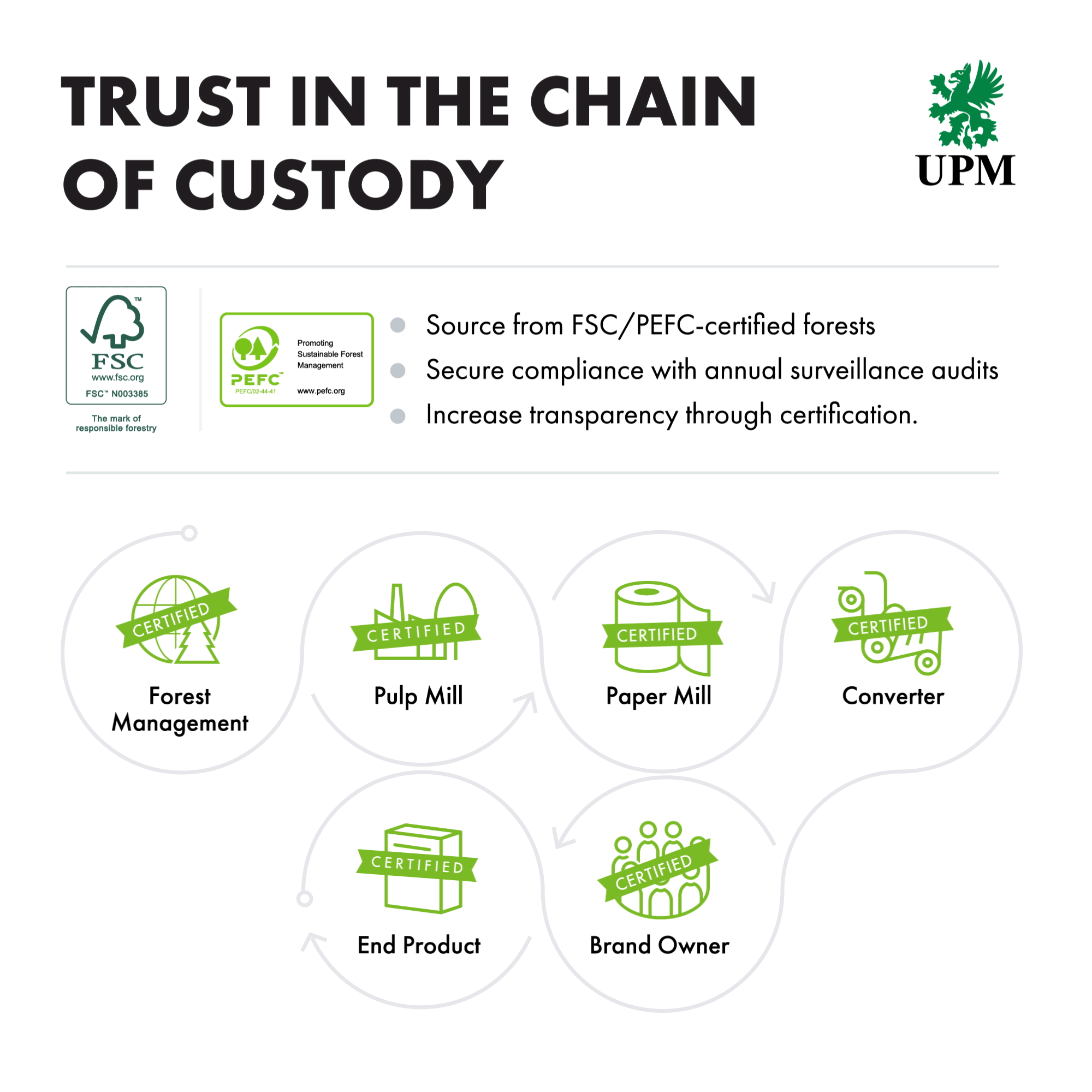Chain of custody is the path from the forest to the point where the product is sold, including each stage of sourcing, processing, trading and distribution, as well as any change in ownership. It is designed to provide credible assurance that the products originate from sustainably managed forests.
However, there is a lot more to it in practice, so join us as we take a deep dive into the world of chain of custody.
Every company is responsible
The forest is the first link in the chain, explains Auvo Kaivola, Secretary General, PEFC Finland: “When the material enters the product or value chain for the first time, the results of the certification audit of that first company ensures that it can be tracked throughout the supply chain. In a sense, the procurement of forest and tree-based products from certified or non-certified forests is a gatekeeping function.”
When trees are harvested, the journey continues with the wood carrier to the pulp mill, and from there to the paper mill, says Anne Lihvonen, Manager, Product Stewardship, Responsibility at UPM. After leaving the mill, the tracing continues via the IT system of each customer and distributor.
“In general, chain of custody certification is a system that covers the whole production and marketing from the forest to the consumers. Each link or company in the product/value chain has responsibilities of their own. There is no collective requirement but whatever position you appear in the supply chain, you must confirm the origin of the wood and if it originates from a certified source,” says Kaivola.
He elaborates by saying that every company in the value chain must have access to information of tree species and the country or countries of harvest. For any uncertified material the company receives, it must minimise the risk that it has not come from a controversial or illegal source. The product, its volume and certified status are recorded in the invoice, bill of lading or delivery note.
 Auvo Kaivola, Secretary General, PEFC Finland
Auvo Kaivola, Secretary General, PEFC Finland
Wood products must be sustainable
The modern production process is complicated. For example, paper might be a mix of virgin fibres or virgin pulpwood and sawmill residue, as well as post and pre-consumer recycled paper. All forest-based components that have a functional purpose in the product must comply with chain of custody requirements.
To be certified, wood must not be harvested in violation of local laws or human rights, or where harvesting would threaten forest conservation efforts. Wood can’t be taken from land being converted to non-forest use. Additionally, some organisations won’t certify wood from forests where genetically modified trees are planted.
A global forest area greater than France and Finland combined was double certified by both the PEFC (PEFC/02-44-41) and FSC™ (FSC N003385) in 2020, an increase of three percent from the previous year. This growth in independent third-party general custody certification reflects a rising trend in companies wanting to demonstrate that they care for forests and are actively fighting forest degradation and deforestation.
However, each company must have clear internal procedures that cover all the requirements of the international chain of custody standard. They must clearly state who is responsible, the management of relevant files and what is required from suppliers, for example.
Transparency and credibility
The chain of custody certification process, which follows ISO 17065 requirements for product certification, is undertaken through the initial certification. A surveillance audit is then performed annually to ensure that everybody in the certified supply chain is complying with the rules and requirements.
“The external third-party auditor assesses whether the system in place at a company is truthful and the operations comply with the requirements. The PEFC is currently studying what blockchain technology and other advancements have to offer to chain of custody certification to increase ease of implementation, transparency and ultimately, credibility,” Kaivola notes.
Part of Lihvonen’s job is to coordinate the third-party general custody certification and manage how to use the official logos to communicate to customers: “UPM is committed to responsible operations in sustainable forestry, so has received chain of custody certifications from the FSC and PEFC, as well as other certifications from many other organisations.”
 Anne Lihvonen, Manager, Product Stewardship, Responsibility at UPM
Anne Lihvonen, Manager, Product Stewardship, Responsibility at UPM
As a major forest owner and purchaser of wood and pulp, UPM also has complete control over the utilisation of this valuable raw material by only sourcing from sustainably managed forests and from legal sources.
Traceability is becoming more important as companies and consumers demand to know if the products and services being used are sustainable. We understand that, which is why transparency plays such an important role in our sustainability goals, so find out for yourself by exploring the UPM Certificate Finder. 
Main image: UPM